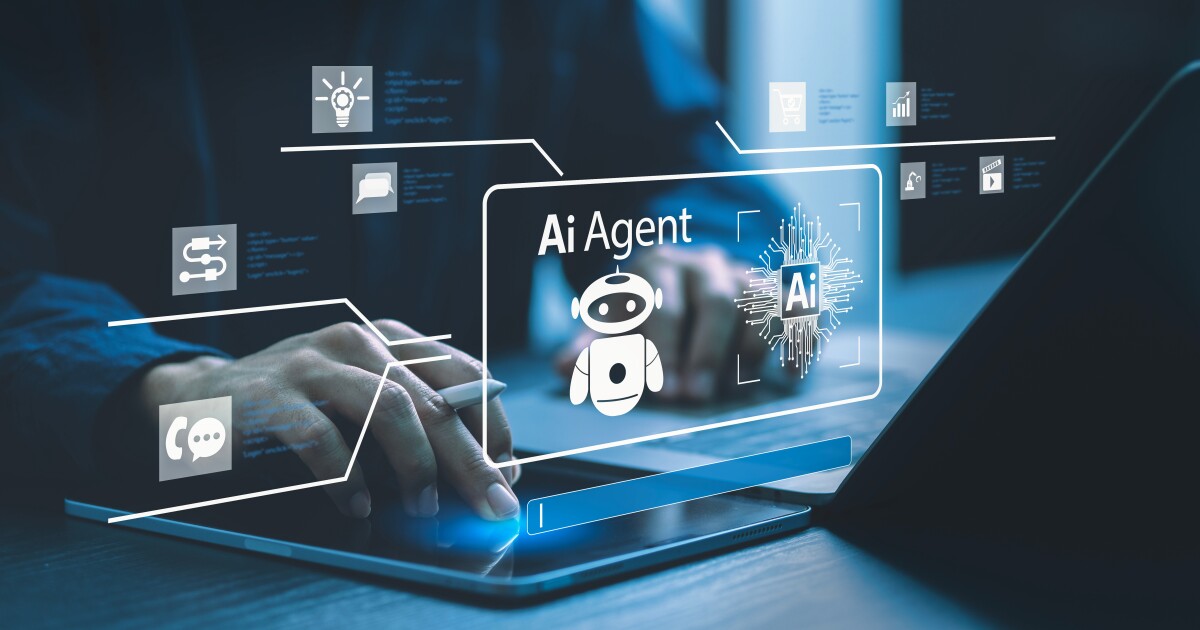Accounting
Agentic AI: small steps, big aspirations at accounting firms
Published
4 months agoon

Despite its relative novelty, major accounting firms have wasted no time in capitalizing on the rise of agentic AI, with technology leaders having already developed and deployed initial solutions for both client work and internal efficiencies.
While the precise definition can vary depending on who is asked, very broadly agentic AI could be described as software that is capable of at least some degree of autonomy to make decisions and interact with tools outside itself in order to achieve some sort of goal—whether booking a flight, sending a bill or buying a gift—without constant human guidance. Agents are not necessarily new, but the rise of generative AI has made them much easier to make and use, as doing so no longer requires specialized coding skills.
Daren Campbell, tax technology transformation leader with Big Four firm EY, said his firm has what is referred to internally as “an agentic AI factory” which is used to facilitate onboarding and upskill staff. The firm starts with identifying processes well-suited for agentic AI integration, then works with those responsible for the process by training them up on the agent factory to build out what they need. This has led to what he called a host of “mini agents” or “a bunch of minions” automating not entire processes end-to-end (yet) but various pieces here and there within the workflow.
“So, it’s not push button returns or anything close to that, but we… are deploying the smaller parts of the process with the intention of getting to the point where we can connect all the mini-agents to have something tackling a larger part of the process,” he said.

As just one example, EY is building out their current anomaly detection solutions, which already use AI to identify and visualize errors. Using agents, he said, will allow them to not just identify errors but propose corrections to those errors for review by a human. Something like this, said Martin Fiore, deputy vice chair of tax for EY Americas, would have been very difficult to do without the aid of AI agents.
“How do you take high volumes of data that would be impossible or not worth an individual spending time on [processing] but one you use AI and in minutes or hours do what used to take years and improve this process? The bots were more reactive, but now we’ve got something proactive. … VAT is a great example, where we have a multinational organization that operates in 120 countries. How do you take that and pull it together in a way that the human can judge against? It is a step you take to get to the next level, if we don’t we can’t get the quality that we need,” he said.
Campbell also pointed to a pilot program with several of their clients where autonomous agents tied to the company’s data actively look for regulatory changes that would affect the jurisdiction they operate from; the agent would flag the change, then notify the tax practitioners and suggest key people (e.g. external advisors, regulatory agencies) they might want to meet with to discuss the matter further. But he stressed that this is a very early development, there isn’t anything like this already in production.
Kelly Fisher, practice partner and technology specialist with top 25 firm Wipfli, said her own firm is currently experimenting on themselves with agentic AI before introducing any new solutions to clients. The most recent thing they did was create a chained series of agents that monitors and reports on legislative and regulatory changes; there is a researcher agent, a curator agent and others that, working together, researches and reports on legislative and regulatory changes for the industries they serve.
“It is for broad brand building insights, one of our goals as an organization was to [keep up with] with the pace at which we are seeing legislative changes or chatter coming out to make sure we deploy information and thought leadership to our clients, applicable specifically to our middle market clients and their insights, faster,” she said.
Asked when they deployed this solution, Fisher said about three weeks ago, speaking to the speed at which even non-coders can build and deploy AI agents.
The firm turned to agents when generative AI alone was not giving them the results they wanted. They added more documents for reference as well as refined their prompts, which did improve the bot though it still felt short of the quality they needed. So the firm then turned to multi-chained agents with specific use cases that work in concert.
“That is a pretty easy win, I would say, with semi-autonomous agents,” she said, adding that they intend to keep refining and improving the application over time.
OJ Laos, director of the AI Lab for Top 25 firm Armanino, said his own firm went through a similar journey. If one defines agentic AI as simply autonomous software, then Armanino has already been experimenting with the technology via research platforms like Microsoft’s AutoGen as well as thirty party solutions like Swarm AI and Crew AI. At its core, he said, these were “bots talking to bots, you could actually see their conversations.” They began doing this about a year ago, using them to do things like query the latest developments in the private equity world.
Fast forward to a year later, and AI models have improved both in terms of their performance as well as the ease of creating them. The old way, he said, was a lot slower and more complicated, and even then the bots would still occasionally “drop the ball between each other.” Recent improvements have led to new possibilities for process automation that would have been impractical just a short time ago.
One of the examples Laos is personally very excited about is enhancements to the firm’s audit platform to automate the document collection process. One of the most common things in audits, he said, is the big list of requests, which has usually called for manual processes to complete. The auditor would send the request list to the client, the client would have to hunt down 50 or more documents and send them to the auditor, who would then need to look at it and figure out where it fits into the larger audit process or, if it doesn’t, send it back to the client.
“This tool lets you just drop everything. If I’m the client, I’d say here’s 50 documents, go knock yourself out. The [agent] looks at them, studies what they are, figures out that this goes to that task, this goes to that auditor, this is for this use case and so on. The auditor still has to look at the evidence to see that it matches and makes sense, but it can dramatically speed that [process] up,” he said.
The next logical step past that, he said, is to have the agent assist with substantive testing, and while this remains only theoretical for now, Laos said this is what they’re eventually building towards.
Armanino has also been experimenting with OpenAI’s new Operator model, which is essentially a browser with agentic AI functions that appear to use the keyboard and mouse to do some task. Specifically, they have been seeing how well it works through RPA with the thought that, in time, it could reduce the need for custom integrations.
Even when a firm doesn’t currently have agentic AI solutions deployed, many intend to do so in the future. Avani Desai, leader of top 50 firm Schellman, said that her own firm has active R&D projects for specific agentic AI use cases both for internal efficiencies and client work.
One solution in development speaks to their cybersecurity specialization. Schellman needs to understand a client’s IT infrastructure before it can offer a proper cybersecurity solution. Right now, they wait for the client to give them this information, which they then review once they’re on site, a lengthy process that she said isn’t even technically a part of the audit itself.
“So one thing we want to focus on from an agentic AI perspective is really on the discovery section, a lot of this can really help our newer associates, even [with] a newer client, get all that information to allow us to just be smarter when we are on site,” she said, adding that they currently don’t plan to focus on testing evidence with AI, as some of their clients aren’t comfortable with that.
Schellman is also developing agentic AI for training purposes, creating a program that can act as a sort of digital worker with knowledge of SOC certification requirements and ISO standards and FedRamp compliance and payment card industry standards to help bring new staff up to speed.
“We [would] have agentic AI help by saying ‘these were past decisions’ so we can improve strategies over time… What we’re really looking at is how we can look at things from a training and awareness perspective,” she said.
Desai added that while they are intrigued by the idea of using agentic AI in compliance audits with no human intervention, “we have decided not to go down that path just yet.”
Schellman is not of the move fast and break things mindset, which explains why they are being very deliberate with their agentic AI ambitions. The ability for agentic AI to make independent decisions and adapt itself in real time, said Desai, creates an entirely new category of risk that must be considered. Humans must be concerned not only about the independent decisions of an AI agent, they must also think about how it dynamically adapts to circumstances and work to make sure it does so in a way that aligns with ethics and guardrails.
“This is why a human in the loop is so important because, at the end of the day, we want agentic AI to run autonomously, that is where you get the value from it, but you need to be really cognizant when you’re designing and developing agents that a human must be a part of that. … I also think there are so many AI policies around AI safety and ethics and governance: that also needs to be part of the development process. At the end of the day we won’t have [as much] human oversight once these autonomous agents start working, but I think you can identify risk and mitigate that risk early in the development lifecycle,” she said.
You may like

By any other name; poor Service; a saga continues; and other highlights of recent tax cases.
Rockford, Illinois: Tax preparer Gretchen Alvarez, 49, has pleaded guilty to preparing and filing false income tax returns.
She operated the tax prep business Sick Credit Repair Tax and Legal Services and represented herself as an income tax preparer. Alvarez did not have a PTIN and admitted that in 2019 and 2020 she misrepresented taxpayers’ eligibility for education credits and deducted fictitious business expenses from their taxable income to reduce tax liabilities and inflate refunds.
The tax loss totaled $356,881.
Sentencing is Sept. 17. Alvarez faces a maximum of three years in prison and a fine of up to $100,000.
Bangor, Maine: Paul Archer, a Florida resident formerly of Hampden and Orrington, Maine, has pleaded guilty to attempting to evade federal taxes and engaging in fraudulent transfers and concealment in a bankruptcy proceeding.
He operated an online marketing business for software installation, earning several million dollars from 2013 through 2015. After an IRS audit in 2016 assessed a federal tax debt totaling some $1 million, Archer concealed and transferred assets through two LLCs he controlled and began using third-party bank accounts to evade paying the tax debt. From April 2018 through November 2019, he transferred and concealed assets and income by using a series of bank accounts held in the names of Max Tune Up LLC; Stealth Kit LLC; his father; and his spouse.
In March 2019, Archer filed for Chapter 7. In his paperwork and court statements, he falsely claimed less than $50,000 in assets; a single checking account; no other assets or property interests; no recent asset transfers; and no connections to any businesses or memberships in any LLCs.
He faces up to five years in prison and a fine up to $250,000 on each of the two charges to which he pleaded guilty. Any sentence will be followed by up to three years of supervised release.
Fort Wayne, Indiana: Rakita Davis, 45, a former IRS employee, has been sentenced to two years of probation and ordered to pay $55,213.61 in restitution to the Small Business Administration after pleading guilty to wire fraud associated with pandemic relief.
Davis falsely claimed gross income for a business that did not exist when she applied for two Paycheck Protection Program loans in 2021. Employed by the IRS when she applied for the loans, Davis lied that she was the sole proprietor of a catering business when no such business existed. She received PPP funds that she spent on such personal items as jewelry, airfare, luxury car rentals and vacations.
Charleston, West Virginia: Business owner Luther A. Hanson has been sentenced to three years of probation and fined $5,000 for willful failure to pay over taxes.
From at least 2015 to September 2020, Hanson, who
Hanson admitted that prior to June 30, 2015, he and the two employees agreed that he would begin treating them as independent contractors. He also admitted that he knew this arrangement would relieve him of paying the employer portion of the employment taxes and of the employees’ withholdings. Neither employee changed their job duties.
He admitted that he knew that neither was an independent contractor while he paid each by check throughout their employment. Hanson further admitted that he did not pay the trust fund taxes to the IRS nor the employer’s share of employment taxes for the two employees each quarter during the arrangement.
The court previously determined that Hanson owed $146,771.37 to the U.S. after his scheme; Hanson paid that amount before sentencing. One of the employees paid a portion of the taxes owed, resulting in the adjusted figure of restitution Hanson owed.

Oakland, New Jersey: Business owner Walter Hass, of Hewitt, New Jersey, has been sentenced to four years in prison for his role in a $3.5 million payroll tax scheme.
Hass owned and operated a shipping and logistics company and since 2014 has operated the company under three different names. He failed to collect, account for and pay over payroll taxes to the IRS on behalf of each of these companies from 2014 to 2022, a total of at least $3.5 million.
Hass used company money to fund his personal lifestyle, including the purchase of luxury vehicles, high-end watches and jewelry, designer clothing, tickets to sporting events, home renovations, vacations, water sports vehicles and extravagant meals.
After signing his guilty plea in October 2023, he embarked on a campaign to avoid responsibility for his conduct. He lied to the court, to the U.S. Probation Office and to the government about a purported cancer diagnosis to delay the entry of his guilty plea and his sentencing. Hass fabricated three letters from physicians asserting that he had medical conditions, including kidney cancer, that prevented him from attending court proceedings. Hass did not have cancer and attempted to travel throughout the country and around the world during this time.
Hass was also sentenced to three years of supervised release and ordered to pay $3,527,645 in restitution.
Atlanta: Attorney Vi Bui has been sentenced to 16 months in prison for obstructing the IRS in connection with his participation in the promotion of abusive syndicated conservation easement tax shelters.
Bui, who
The scheme entailed creating partnerships that bought land and land-owning companies and donated easements over that land or the land itself. Appraisers generated fraudulent and inflated appraisals of the easements, and the partnerships then claimed a charitable contribution deduction based on the inflated value. Bui knew that to make it appear that the participants had timely purchased their units in the shelters, Fisher, Sinnott and others backdated and instructed others to backdate documents, including subscription agreements and checks.
Bui anticipated that the transactions would be audited. He and others created and disseminated lengthy documents disguising the true nature of the transaction, instituted sham “votes” for what to do with the land that the partnership owned despite knowing that outcome was predetermined, and falsified paperwork such as appraisals and subscription agreements. Bui earned substantial income for his role in the scheme.
He also used the fraudulent shelters to evade his own taxes, filing personal returns from 2013 through 2018 that claimed false deductions from the shelters.
He was also ordered to serve a year of supervised release and to pay $8,250,244 in total restitution to the IRS.


The International Financial Reporting Standards Foundation has posted profiles of 17 of the 36 jurisdictions around the world that have either adopted or used International Sustainability Standards Board disclosures or are in the process of finalizing steps to introduce the IFRS Sustainability Disclosure Standards in their regulatory frameworks.
The
“Why is the IFRS Foundation publishing these jurisdictional profiles, which set out by country or jurisdiction their approach to sustainability reporting. It’s really because we see this as part of our commitment to provide transparency to the market,” said ISSB vice chair Sue Lloyd during a press briefing. “It’s all very well talking about the use of our standards, but we know that different jurisdictions have made different decisions. They’re adopting the standards at a different pace, and by providing these profiles, we want to provide clarity, particularly for investors who are going to be relying on understanding the comparability of information between jurisdictions, to alert them to the similarities and differences in approach and to describe the extent to which we are achieving the global comparability that we have been working toward with the ISSB standards.”
She noted that the ISSB’s sister board, the International Accounting Standards Board, has also been publishing
The profiles are accompanied by 16 snapshots that provide a high-level overview of other jurisdictions’ regulatory approaches that are still subject to finalization. Of the 17 jurisdictions profiled, 14 have set a target of “fully adopting” ISSB standards, two have set a target of ‘adopting the climate requirements’ of ISSB standards, and one targets “partially incorporating” ISSB Standards. The profiled jurisdictions cover Australia, Bangladesh, Brazil, Chile, Ghana, Hong Kong, Jordan, Kenya, Malaysia, Mexico, Nigeria, Pakistan, Sri Lanka, Chinese Taipei, Tanzania, Türkiye and Zambia.
Accounting Today asked Lloyd about the United States, where the Securities and Exchange Commission’s
“What we are seeing continue to be the case in the U.S. is very strong investor interest in sustainability information, including from the use of the ISSB standards,” Lloyd said. “We also have interest from companies who can choose to provide the information using our standards. Of course, many companies in the U.S. in the past have chosen to use the Sustainability Accounting Standards Board standards voluntarily, so that sort of voluntary adoption momentum is something we still see from the company and the investor side.”
“I think it’s also important to remember that the SEC just recently reconfirmed that if information on things like climate is material, there’s already a requirement to provide material information in accordance with existing requirements in place,” she continued. “And the last thing I’d note on the U.S. front is that while the SEC has indeed moved away from their proposed rule, we do see action at a state level, including, for example, in California, where the CARB [California Air Resources Board] is looking at climate disclosures, including the potential to allow the use of the ISSB standards to meet those requirements, so we see progress, but in different ways perhaps.”
The
Of the 16 jurisdictional snapshots published by the IFRS Foundation, 12 propose or have published standards (or requirements) that are fully aligned with ISSB standards (such as Canada) or are designed to deliver outcomes functionally aligned with those resulting from the application of ISSB standards (such as Japan). Three propose standards (or requirements) that incorporate a significant portion of disclosures required by ISSB standards, and one is considering allowing the use of ISSB standards. For these jurisdictions, their target approach to adoption is yet to be finalized. Once jurisdictions have finalized their decisions on adoption or other use of ISSB standards, the IFRS Foundation plans to publish a profile for these jurisdictions.
“The ISSB standards are bringing clarity to investors on the risks and opportunities lying in value chains across time horizons in a rapidly changing world,” said ISSB chair Emmanuel Faber in a statement Thursday. “A year ago, we committed to publishing detailed jurisdictional profiles describing adoption of our standards to complement our Inaugural Jurisdictional Guide. The profiles provide a detailed current state-of-play to investors, banks, and insurers who continue to struggle with the lack of appropriate, comparable and reliable information on these critical factors affecting business prospects. We have seen new jurisdictions joining the initial cohort of ISSB adopters every month, with a total of 36 today.”
Accounting
IRS extends deadline on crypto broker reporting and withholding
Published
19 hours agoon
June 12, 2025

The Treasury Department and the Internal Revenue Service are giving cryptocurrency brokers additional time to comply with requirements to report on digital asset sales and withhold taxes.
In
In 2024, Treasury and IRS
The IRS said it has received and carefully considered comments from the public about the transition relief provided in Notice 2024-56 indicating that brokers needed more time to comply with the reporting requirements; today’s notice addresses those comments.
In the new Notice 2025-33, the Treasury and the IRS extended the transition relief from backup withholding tax liability and associated penalties for any broker that fails to withhold and pay the backup withholding tax for any digital asset sale or exchange transaction effected during calendar year 2026.
The Trump administration has been notably more supportive of the crypto industry since taking office,
The notice also extends the limited transition relief from backup withholding tax liability for an extra year. That means brokers won’t be required to backup withhold for any digital asset sale or exchange transactions effected in 2027 for a customer (payee), if the broker submits that payee’s name and tax identification number to the IRS’s TIN Matching Program and receives a response that the name and TIN combination matches IRS records. They’re also granting relief to brokers that fail to withhold and pay the full backup withholding tax due, if the failure is due to a decrease in the value of withheld digital assets in a sale of digital assets in return for different digital assets in 2027, and the broker immediately liquidates the withheld digital assets for cash.
This notice also includes more transition relief for brokers for sales of digital assets effected during calendar year 2027 for certain customers that haven’t been previously classified by the broker as U.S. persons.

Consumer sentiment reading rebounds to much higher level than expected as people get over tariff shock

CVX, UAL, NOC, RH and more

Summer Fridays are increasingly rare as hybrid schedules gain steam

New 2023 K-1 instructions stir the CAMT pot for partnerships and corporations

The Essential Practice of Bank and Credit Card Statement Reconciliation

Are American progressives making themselves sad?
Trending
-

 Economics7 days ago
Economics7 days agoJobs report May 2025:
-

 Economics7 days ago
Economics7 days agoDonald Trump has many ways to hurt Elon Musk
-

 Economics5 days ago
Economics5 days agoSending the National Guard to LA is not about stopping rioting
-

 Finance7 days ago
Finance7 days agoStocks making the biggest moves midday: WOOF, TSLA, CRCL, LULU
-

 Economics7 days ago
Economics7 days agoDonald Trump has many ways to hurt Elon Musk
-

 Blog Post6 days ago
Blog Post6 days agoMastering Bookkeeping Tasks During Peak Business Seasons
-

 Personal Finance5 days ago
Personal Finance5 days agoWhat Pell Grant changes in Trump budget, House tax bill mean for students
-

 Economics1 week ago
Economics1 week agoRussia cuts sky-high interest rates for the first time since 2022
